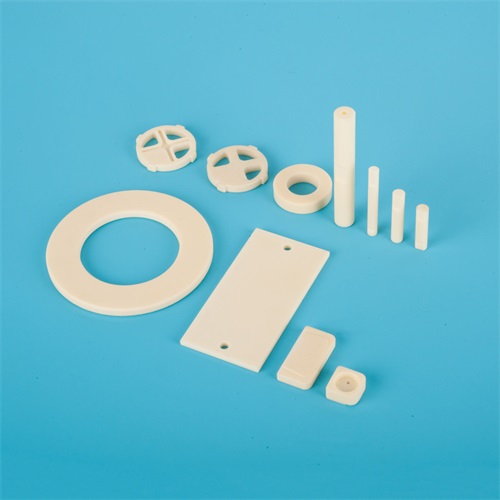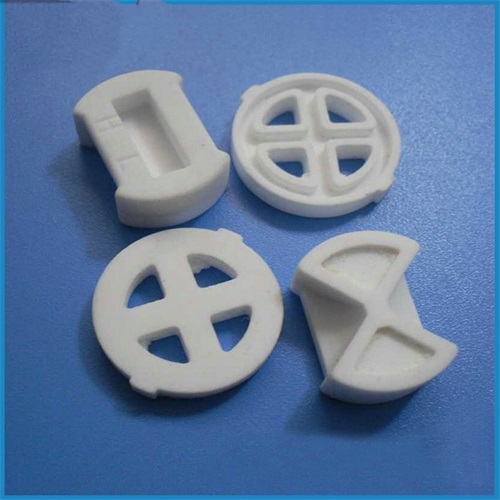Advantages and Application of Alumina Ceramic Valve Plates in High Pressure Valves
Performance advantages of alumina ceramic valves
- Ultra-high hardness and wear resistance
The Rockwell hardness of the alumina ceramic valve plate is as high as HRC90, second only to diamond. This ultra-high hardness allows it to maintain surface integrity for a long time in the face of high-speed fluid initialization and solid particle impact, reducing seal failure and flow control deviation due to wear. For example, in high-pressure valves in mine concentrators, the average maintenance cycle of the valve was extended from 3 months to more than 1 year after using the alumina ceramic valve plate. - Super corrosion resistance
Alumina ceramics have a high degree of chemical stability and can resist the erosion of a variety of strong acids, strong alkalis and organic solvents. In the corrosive medium conveying system of chemical, pharmaceutical and other industries, alumina ceramic valves can always maintain stable performance and will not deteriorate due to chemical corrosion, effectively avoiding safety accidents caused by corrosion leakage. - Excellent high temperature resistance
The melting point of alumina ceramic valves is as high as 2050 ° C, and it has a very low coefficient of thermal expansion in high temperature environments. Its operating temperature range covers -29 ° C to 540 ° C, which can effectively cope with complex working conditions such as high temperature steam, ensuring the sealing and stability of the valve under high temperature conditions. - Excellent sealing performance
The surface of the alumina ceramic valve plate is polished with high precision, and the surface finish is extremely high, which can be tightly fitted with the valve seat. Even under the working conditions of high pressure difference, it can effectively prevent medium leakage and ensure that the sealing performance of the valve is always stable and reliable. - Lightweight and low friction coefficient
The density of alumina ceramic material is only one-third that of steel, and the use of ceramic valves can reduce the overall weight of the equipment. At the same time, its low friction coefficient makes the valve smoother and less powerful during opening and closing.

Application of Alumina Ceramic Valve Plate in High Pressure Valve
- Power industry
In thermal power generation, hydropower generation and nuclear power generation, high-pressure valves are used to control the flow of steam, water, chemical reagents and other media. Alumina ceramic valves can effectively cope with complex working conditions such as high temperature, high pressure, high wear and strong corrosion, ensuring the safe and stable operation of power systems. - Petrochemical industry
Petrochemical production involves a variety of flammable, explosive and highly corrosive media, which requires extremely demanding performance of valves. Alumina ceramic valves can reliably control the flow and pressure of the medium in the process of petroleum refining and chemical synthesis, prevent leakage accidents, and ensure the safety and efficiency of the production process. - Metallurgical industry
In the metallurgical production process of steel and non-ferrous metals, high-pressure valves are used to control the emission of high-temperature slag, molten metal and various corrosive gases. The high temperature resistance, wear resistance and corrosion resistance of alumina ceramic valves make them an ideal choice for high-pressure valves in the metallurgical industry, which can effectively prolong the service life of valves and reduce equipment maintenance costs. - Natural gas industry
During the long-distance transportation of natural gas, the pressure is usually at a high level, and the pressure of some gas transmission trunk lines can reach 10 MPa or even higher. Alumina ceramic valves can easily withstand huge pressure, and at the same time have excellent corrosion resistance to acid gases, moisture and impurities in natural gas, ensuring the safe and stable operation of the natural gas transmission system. - Automotive engine field
In the automobile engine system, the valve plate is a key component to control the opening and closing of the intake and exhaust passages, and its performance directly affects the fuel efficiency, power output and durability. Alumina ceramic valves are becoming a new choice for engine upgrades due to their advantages of high temperature resistance, wear resistance and low friction coefficient. - High temperature steam system
In the food processing, pharmaceutical, power production and other industries, high temperature steam is widely used in heating, disinfection, power drive and other processes. Alumina ceramic valves can maintain good sealing performance in high temperature steam systems, effectively prevent steam leakage, and resist the erosion of various corrosive substances in high temperature steam.

With its excellent wear resistance, corrosion resistance, high temperature resistance, sealing performance and lightweight advantages, alumina ceramic valves are gradually replacing traditional metal valves and becoming the preferred material in the field of high pressure valves. Its wide application in many industrial fields such as electric power, petrochemical, metallurgy, natural gas, automobile engines and high temperature steam systems not only improves the reliability and safety of equipment, but also significantly reduces maintenance costs, providing a strong guarantee for the efficient operation of industrial production.
PREVIOUS:What industries can the sealing effect of ceramic flanges be applied to
NEXT:Advantages of Alumina Ceramic Valves in High Temperature Steam Systems
CATEGORIES
LATEST NEWS
- Petrochemical ceramic injec...
- Zirconia Ceramic Rod Custom...
- High-temperature resistance...
- What is the wear resistance...
- What is the hardness of cer...
- Aluminum oxide ceramic cust...
- What are the main aspects o...
- What are the mechanical pro...
- Thermal properties of zirco...
- What properties should be c...
